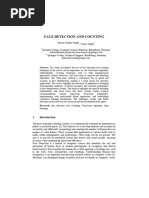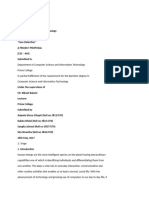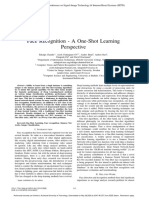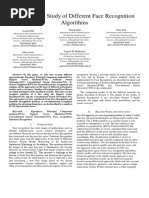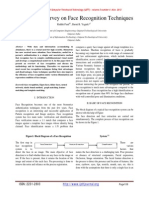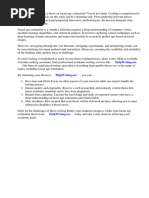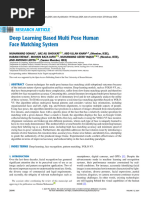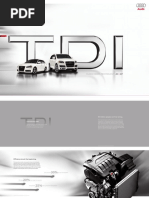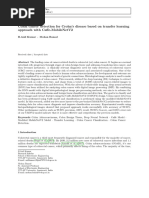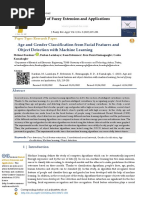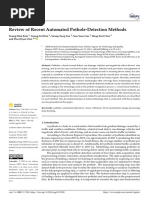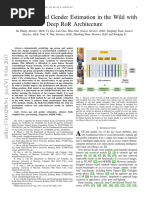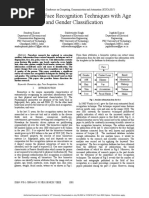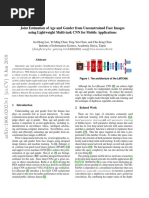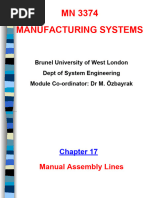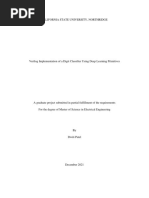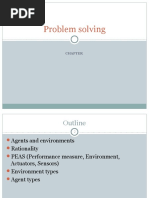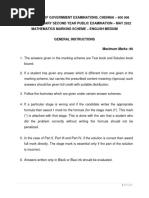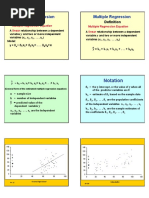Age and Gender Detection Using Python
Age and Gender Detection Using Python
Uploaded by
Anil Kumar BCopyright:
Available Formats
Age and Gender Detection Using Python
Age and Gender Detection Using Python
Uploaded by
Anil Kumar BOriginal Title
Copyright
Available Formats
Share this document
Did you find this document useful?
Is this content inappropriate?
Copyright:
Available Formats
Age and Gender Detection Using Python
Age and Gender Detection Using Python
Uploaded by
Anil Kumar BCopyright:
Available Formats
International Journal of Scientific Research in Engineering and Management (IJSREM)
Volume: 06 Issue: 05 | May - 2022 Impact Factor: 7.185 ISSN: 2582-3930
AGE AND GENDER DETECTION USING PYTHON
Hrutik Ghude1, Ganesh Chirme2, Sanket Jagtap3, Prof. Muneesh Pal4
1,2,3
Department of Information Technology, Alamuri Ratnamala Institute of Engineering and Technology
4
Department of Computer Engineering, Alamuri Ratnamala Institute of Engineering and Technology
chose a bunch of frail classifiers from the face finder for
Abstract - Automatic age and orientation order has orientation and identity acknowledgment. Rather than
become pertinent to a rising measure of utilizations, square shape highlights, Shummet and Henry[7] planned
especially since the ascent of social stages and online another arrangement of powerless classifiers which utilize
entertainment. Neertheless, execution of existing the connection between twopixels' forces as highlights,
techniques on genuine pictures is still essentially and show that the acknowledgment rate can be
missing, particularly when com-pared to the colossal additionally moved along. Rather than AdaBoost,
jumps in execution as of late re-ported for the Moghaddam and Yang [8] explored the utilization of
connected errand of face acknowledgment. In this nonlinear help vector machines (SVMs) to order
paper we show that by learning portrayals using orientation from face pictures. With the Gaussian spiral
profound convolutional brain organizations (CNN), a premise work (RBF) part, a high. Notwithstanding, the
critical expansion in execution can be acquired on these computational heaps of these two methodologies are high.
assignments. To this end, we propose a basic They are subsequently not appropriate forongoing
convolutional net design that can be utilized in any applications. Among the abovementioned, the
event, when how much it is restricted to learn Shakhnarovich and Viola's strategy [6] is presumably the
information. We assess our technique on the new most proficient one with regards to the computational
Adience benchmark for age and orientation assessment expense for genuine applications. It is on the grounds that
and show it to beat present status of-the-workmanship that a portion of the square shape highlights utilized for
strategies decisively. face location are re-utilized for orientation
Keywords- Face Detection, Skin Color Segmentation, acknowledgment.
Face Features extraction, Features recognization,
Fuzzy rules. 2. Related Works
Programmed age and orientation grouping has become
1. INTRODUCTION pertinent to a rising measure of utilizations, especially
since the ascent of social stages and web-based
Human's countenances uncover different data including entertainment. Neertheless, execution of existing strategies
orientation, age and identity. They give significant signals on genuine pictures is still fundamentally missing,
to numerous applications, for example, biometric particularly when com-pared to the colossal jumps in
validation and shrewd human- execution as of late re-ported for the connected
undertaking of face acknowledgment. In this paper we
show that by learning portrayals using profound
PC interface. In this paper, we present another strategy convolutional brain organizations (CNN), a huge
that can recognize people's sexual orientations from their expansion in execution can be gotten on these errands. To
face images.In the past, many explores dedicate to this end, we propose a straightforward convolutional net
observing great picture highlights for orientation design that can be utilized in any event, when how much it
acknowledgment. Among them, Adaboost [1] [2] [3] [4] is is restricted to learn information. We assess our strategy
a decent device for include determination. There are on the new Adience benchmark for age and orientation
numerous orientation acknowledgment calculations assessment and show it to beat present status of-the-
developed in view of AdaBoost. Wu and Ai [5] proposed a craftsmanship techniques emphatically
supporting technique in light of the look-into table (LUT)
frail classifiers. In their work, they train three distinct 2.1Age classification.
finders (orientation, nationality, and age) to procure
segment data by utilizing the two-class Real AdaBoost The issue of naturally extricating age related credits from
calculation [2]. Shakhnarovich and Viola [6] utilized facial pictures has gotten expanding consideration lately
Viola and Jones' flowed AdaBoostmethod [1] to prepare a and numerous strategies have been put fourth. A point by
face indicator, which is a straight mix of the feeble point study of such techniques can be found] and, all the
classifiers chose from square shape highlights. They then more as of late, in . We note that de-show disdain toward
© 2022, IJSREM | www.ijsrem.com | Page 1
International Journal of Scientific Research in Engineering and Management (IJSREM)
Volume: 06 Issue: 05 | May - 2022 Impact Factor: 7.185 ISSN: 2582-3930
our attention here on age bunch order instead of exact age Image Preprocessing.
assessment (i.e., age relapse), the review be-low
incorporates strategies intended for one or the other errand. Savvy age and orientation classifiers tackle the
classification task under unfiltered genuine settings. The
2.2 Gender classification. vast majority of those face pictures are not adjusted and
nonfrontal and furthermore with different levels of
A definite study of orientation order strategies can be varieties in present, appearance, lighting, and foundation
found in [and all the more as of late in here we rapidly conditions. Hence, those in-the-wild face pictures need
overview important techniques. first to be recognized, then, at that point, adjusted, and,
finally, utilized as contribution for the classifiers. The
One of the early strategies for orientation grouping utilized picture preprocessing stage as displayed in Figure 2 is
a brain network prepared on a little arrangement of close made sense of in additional subtleties beneath.
front facing face pictures. In the consolidated 3D design of
the head (got utilizing a laser scanner) and picture powers Face Detection. The first phase of picture preprocessing is
were utilized for characterizing orientation. SVM face identification. The face discovery stage finds the face
classifiers were utilized by, applied straightforwardly to in an information picture. In this work, we utilize an open-
picture powers. Instead of utilizing SVM, involved source face indicator: Head Hunter portrayed in [54]. To
AdaBoost for a similar reason, here once more, applied to identify a face, every one of the info pictures are pivoted
picture forces. in the scope of 90° to 90° points and with the progression
of 5°. From that point forward, the finder chooses the info
3. Proposed Algorithm picture with the best result of the face locator and for a
A. Gender Recognization situation where the face isn't recognized in all the
modifications of the information picture, the first info
1. Input an Image picture is upscaled and face identification calculation is
2. Detect skin area in Input Image. rehashed until a face is distinguished. The upscaling helps
3. Detect Features like eyes and mouth in skin region. in identifying faces in every one of the information
4. If Features detected then go to step 5 else step 1. pictures.
5. Crop Face.
6. Load Database Male Females features. Landmark Detection and Face Alignment. After face
7. Locate Features in a face area. recognition, is the facial milestone discovery and face
8. Count Male & female Features. adjust ment stage, where we utilize the cutting edge
9. Filter Counted features into strong & weak features. arrangement in [10]. This picture preprocessing
10. Form Fuzzy Conclusion from features & Display arrangement is an open-source multiview facial milestone
genderresult. recognition calculation that utilizes five milestone
B. Age Prediction discovery models, including a front facing model, two
1) Training half-profile models, and two full profile models.
1. Select an Input Image.
2. Detect skin area in Input Image. CNN Architecture. Our CNN design is an original six-
layer organization, including four convolutional and two
3. Detect Features like eyes and mouth in skin region.
4. If Features detected then go to step 5 else step completely associated layers. The CNN configuration is a
5. Crop Face. start to finish consecutive profound learning engineering,
6. Save Face into Database with its age. including highlight ex-footing and classification stages.
7. Repeat step 1 to 6 for 100 images (Training Images) The element extraction stage has four convolutional layers,
with the relating boundaries, including the quantity of
filters, the portion size of each filter, and the step. It
2) Testing
contains the convolutional layer, actuation layer (rectified
1. Select an Input Image.
straight unit (ReLU)), clump standardization (rather than
2. Detect skin area in Input Image.
3. Detect Features like eyes and mouth in skin region. the regular Local Response Normalization), max-pooling
layer, and a dropout [56] (all the convolutional layers have
4. If Features detected then go to step 5 else step
a fixed dropout of 25%). The classification stage, then
5. Crop Face.
again, contains two completely associated layers, that
6. Load faces Images from training directory &
handle the classification period of the model. The first
Match With input face image.
completely associated layer contains 512 neurons, trailed
7. Retrieve Match image age from database.
by a ReLU, then group standardization, and, finally, a
8. Display Result.
dropout layer at a dropout proportion of 0.5. The second
9. Stop
and the last completely associated layer yield 512
highlights which are Training Details. In this part, we
© 2022, IJSREM | www.ijsrem.com | Page 2
International Journal of Scientific Research in Engineering and Management (IJSREM)
Volume: 06 Issue: 05 | May - 2022 Impact Factor: 7.185 ISSN: 2582-3930
portray the preparation subtleties for age gathering and 5.Result
orientation classifiers on IMDb, MORPH-II, and OIU-
Adience datasets benchmark. The age bunch classifier will
be answerable for foreseeing the age gatherings of The following image is a output of this project, which
unfiltered human's face pictures into eight different classes, shows the gender is male and age range from 8 to 12 .
while orientation classifier will order those face pictures
into two orientation classes.
For every one of our analyses, we instated and prepared
our CNN model without any preparation, utilizing the
pictures and the marks of IMDb and MORPH-II datasets
benchmark. We fundamentally pretrained the clever CNN
design on the IMDb-WIKI unfiltered facial maturing
dataset whose pictures are acquired straightforwardly from
the site with a few level of changeability and afterward
fine-tuned the CNN on the pictures from the MORPH-II
dataset, to keep away from overfitting and furthermore to
adjust the CNN model to confront picture items in the
undertaking to perform. At last, we tuned the organization
on the preparation part of the genuine dataset (OIU-
Adience) on which we assessed. The fine-tuning permits
the CNN to get the conveyance, the particularities, and the
predisposition of each dataset, thus working on the 6.Conclusion and Future Works
exhibition.
We handled the classification old enough gathering and
orientation of unfiltered certifiable face pictures. We
Age Group Classification.
represented the errand as amulticlass classification issue
To prepare the age bunch CNN based classifier to foresee and, in that capacity, train the model with a classification-
unfiltered face pictures into the right age bunch and after based misfortune work as preparing targets. Our proposed
series of exact examinations, we set the underlying model is initially pretrained on age and orientation named
learning rate to be 0.0001 to permit model train longer and enormous scope IMDb-WIKI dataset, whose pictures are
afterward utilize a L2 weight rot of 0.0005. To make our gotten straightforwardly from the site with a few level of
model ready to sum up and foresee accurately, we apply inconstancy and afterward fine-tuned on MORPH-II,
Adam analyzer to refresh network loads during preparing. another huge scope facial maturing dataset with age and
orientation comments. At last, we utilize the first dataset
4.Experiments (OIU-Adience benchmark of unfiltered faces for age and
orientation classification) to fine-tune this model. The
In this segment, we first present the datasets with a powerful picture preprocessing calculation, handles a
depiction of their specifications and present the portion of the fluctuation saw in ordinary unfiltered
exploratory examination and consequences of the genuine countenances, and this confirms the model
investigations when assessed for age gathering and materialness for age gathering and orientation
orientation classifications exactness. classification in nature. At long last, we examine the
classfication exactness on OIU Adience dataset for age and
Datasets. For the age gathering and orientation orientation; our proposed strategy accomplishes the cutting
classification, we assess the proposed strategy on OIU- edge execution, in both age gathering and orientation
Adience [12] dataset. IMDb-WIKI [2] and MORPH-II ] classification, significantly outflanking the current models.
datasets are likewise utilized to pretrain our organization For future works, we will consider a more profound CNN
while assessing the classifiers on OIU-Adience dataset. A engineering and a more strong picture handling calculation
short rundown of those datasets is given in Table 3, with for precise age assessment. Additionally, the obvious age
the size of each dataset, age-range data, and the quantity of assessment of human's face will be fascinating
subjects. Figure 3 likewise presents some example pictures examination to research from now on.
of each dataset. Here, we take a concise presentation of
those datasets and their specifications.
© 2022, IJSREM | www.ijsrem.com | Page 3
International Journal of Scientific Research in Engineering and Management (IJSREM)
Volume: 06 Issue: 05 | May - 2022 Impact Factor: 7.185 ISSN: 2582-3930
References
[1] E.Agustsson, R.Timofte S.Escalera, X. Baro, I.
Guyon, and R. Rothe, “Apparent and real age
estimation in still images with deep residual
regressors on appareal database,” in Proceedings of
the 2017 12th IEEE International Conference on
Automatic Face & Gesture Recognition (FG 2017),
Biometrics Wild, Bwild, Washington, DC, USA, pp.
87–94, June 2017.
[2] K. Zhang, C. Gao, L. Guo et al., “Age group and
gender estimation in the wild with deep RoR
architecture,” IEEE Access, vol. 5, pp. 22492–
22503, 2017.
[3] A. Kuehlkamp, “Age estimation from face images,”
in Pro- ceedings of the 6th IAPR International
Conference on Bio- metrics (ICB), pp. 1–10, Madrid,
Spain, June 2013.
[4] V. Carletti, A. S. Greco, G. Percannella, M.
Vento, and
I. Fellow, “Age from faces in the deep learning
revolution,” IEEE Transactions on Pattern Analysis
and Machine Intelli- gence, p. 1, 2019.
[5] B. Bin Gao, H. Y. Zhou, J. Wu, and X. Geng, “Age
estimation using expectation of label distribution
learning,” in Pro- ceedings of the Twenty-Seventh
International Joint Conference on Artificial
Intelligence, pp. 712–718, Stockholm, Sweden, July
2018.
[6] R. C. Malli, M. Aygun, and H. K. Ekenel, “Apparent
age estimation using ensemble of deep learning
models,” in Proceedings of the IEEE Computer
Society Conference on Computer Vision and
Pattern Recognition Workshops, pp. 714–721, Las
Vegas, NV, USA, June 2016.
[7] G. Antipov, M. Baccouche, S. A. Berrani, and J. L.
Dugelay, “Apparent age estimation from face
images combining
general and children-specialized deep learning
models,” in Proceedings of the IEEE Conference on
Computer Vision and Pattern Recognition
Workshops (CVPRW), pp. 801–809, Las Vegas,
NV, USA, June 2016.
[8] G. Antipov, M. Baccouche, S. A. Berrani, and J. L.
Dugelay, “Effective training of convolutional neural
networks for face- based gender and age prediction,”
Pattern Recognition, vol. 72, pp. 15–26, 2017.
[9] R. Rothe, R. Timofte, and L. Van Gool, “Deep
expectation of real and apparent age from a single
image without facial landmarks,” International
Journal of Computer Vision, vol. 126, no. 2–4, pp.
144–157, 2018.
[10] H. Han and A. K. Jain, “Age, gender and race
estimation from unconstrained face images,” MSU
Technical Report, MSU- CSE-14-5, Michigan State
University, East Lansing, MI, USA, 2014.
© 2022, IJSREM | www.ijsrem.com | Page 4
You might also like
- Detection of Gender and Age Using Machine LearningDocument8 pagesDetection of Gender and Age Using Machine LearningIJRASETPublicationsNo ratings yet
- DNN Based Smart Attendance Management System: Related WorkDocument5 pagesDNN Based Smart Attendance Management System: Related WorkNaren DranNo ratings yet
- Age Estimation in Facial Images Using Histogram EqualizationDocument5 pagesAge Estimation in Facial Images Using Histogram EqualizationtresaNo ratings yet
- Referensi Mas Surya PDFDocument8 pagesReferensi Mas Surya PDFJamil Al-idrusNo ratings yet
- Highly Secured Online Voting System (OVS) Over NetworkDocument6 pagesHighly Secured Online Voting System (OVS) Over Networkijbui iirNo ratings yet
- Effect of Distance Measures in Pca Based Face: RecognitionDocument15 pagesEffect of Distance Measures in Pca Based Face: Recognitionadmin2146No ratings yet
- E-13 revised project paperDocument5 pagesE-13 revised project paperBompally NehaNo ratings yet
- Recent Generative Adversarial Approach IDocument28 pagesRecent Generative Adversarial Approach IyusrafaisalcsNo ratings yet
- Confidential E-Voting System Using Face Detection and RecognitionDocument5 pagesConfidential E-Voting System Using Face Detection and RecognitionInternational Journal of Engineering and TechniquesNo ratings yet
- 1 s2.0 S1319157820304821 MainDocument7 pages1 s2.0 S1319157820304821 MainrsoekartaNo ratings yet
- Face Photo Sketch Recognition Using DeepDocument6 pagesFace Photo Sketch Recognition Using DeepDr. Md. Salah Uddin YusufNo ratings yet
- 02 Springer Paper TemplateDocument17 pages02 Springer Paper Templateaamir khanNo ratings yet
- Cross Pose Facial Recognition Method For Tracking Any Person's Location An ApproachDocument5 pagesCross Pose Facial Recognition Method For Tracking Any Person's Location An ApproachEditor IJTSRDNo ratings yet
- Face Recognition System Using Self Organizing Feature Map and Appearance Based ApproachDocument6 pagesFace Recognition System Using Self Organizing Feature Map and Appearance Based ApproachEditor IJTSRDNo ratings yet
- 804 ArticleText 2782 1 10 20170810Document7 pages804 ArticleText 2782 1 10 20170810Zoelefack Reyna NkoumboukNo ratings yet
- IRJET-A Comprehensive Survey and Detaile PDFDocument7 pagesIRJET-A Comprehensive Survey and Detaile PDFnedal altitiNo ratings yet
- Tri-Axial Slicing For 3D Face Recognition From Adapted Rotational Invariants Spatial Moments and Minimal Keypoints DependenceDocument8 pagesTri-Axial Slicing For 3D Face Recognition From Adapted Rotational Invariants Spatial Moments and Minimal Keypoints DependenceAnitha JersonNo ratings yet
- Proposal for the ReasearchDocument6 pagesProposal for the Reasearchamanueltufa71No ratings yet
- Music Recommendation Based On Facial ExpressionDocument4 pagesMusic Recommendation Based On Facial ExpressionInternational Journal of Innovative Science and Research TechnologyNo ratings yet
- Irjet V4i5112 PDFDocument5 pagesIrjet V4i5112 PDFAnonymous plQ7aHUNo ratings yet
- A Survey of Face Recognition Approach: Jigar M. Pandya, Devang Rathod, Jigna J. JadavDocument4 pagesA Survey of Face Recognition Approach: Jigar M. Pandya, Devang Rathod, Jigna J. JadavSalman umerNo ratings yet
- 10.1109@CONFLUENCE.2019.8776934Document4 pages10.1109@CONFLUENCE.2019.8776934mbilal00147No ratings yet
- Real Time Gender Classification and Age EstimationDocument3 pagesReal Time Gender Classification and Age EstimationSNEHAL HASENo ratings yet
- GRA Net A Deep Learning Model For Classification of Age and Gender From Facial ImagesDocument18 pagesGRA Net A Deep Learning Model For Classification of Age and Gender From Facial ImagesAnil Kumar BNo ratings yet
- Correlation Method Based PCA Subspace Using Accelerated Binary Particle Swarm Optimization For Enhanced Face RecognitionDocument4 pagesCorrelation Method Based PCA Subspace Using Accelerated Binary Particle Swarm Optimization For Enhanced Face RecognitionEditor IJRITCCNo ratings yet
- 1 s2.0 S1319157821002536 MainDocument11 pages1 s2.0 S1319157821002536 MainpokebreadsNo ratings yet
- Haar CascadeDocument6 pagesHaar CascadePrince KumarNo ratings yet
- Sensors: Face Detection Ensemble With Methods Using Depth Information To Filter False PositivesDocument18 pagesSensors: Face Detection Ensemble With Methods Using Depth Information To Filter False PositivesAlina Maria CocîrneațăNo ratings yet
- Chanda 2019Document7 pagesChanda 2019arifNo ratings yet
- Ioegc 12 131 12188Document8 pagesIoegc 12 131 12188yusrafaisalcsNo ratings yet
- Study of Face Recognition Techniques: A SurveyDocument8 pagesStudy of Face Recognition Techniques: A SurveyGitaNo ratings yet
- $uhylhzrqidfldoihdwxuhh (Wudfwlrqwhfkqltxh: Hhwlnd6Lqjk DQG, Qgx&KkdeudDocument11 pages$uhylhzrqidfldoihdwxuhh (Wudfwlrqwhfkqltxh: Hhwlnd6Lqjk DQG, Qgx&KkdeudNicholas DawsonNo ratings yet
- Age and Gender Detection System Using Raspberry PiDocument6 pagesAge and Gender Detection System Using Raspberry Pishital shermaleNo ratings yet
- Aayush Nihar Soham Maitrik Yagnesh ML Project ReportDocument9 pagesAayush Nihar Soham Maitrik Yagnesh ML Project ReportNihar ShahNo ratings yet
- Partially Covered Face Detection in Presence of Headscarf For Surveillance ApplicationsDocument5 pagesPartially Covered Face Detection in Presence of Headscarf For Surveillance Applicationsdineth.gdNo ratings yet
- PaperSummary VSDocument2 pagesPaperSummary VSHirtika MirghaniNo ratings yet
- Convolutional Neural Networks For Facial Expression RecognitionDocument7 pagesConvolutional Neural Networks For Facial Expression RecognitionEditor IJTSRDNo ratings yet
- Face Detection and Recognition: A Review: February 2018Document4 pagesFace Detection and Recognition: A Review: February 2018Henry MagdayNo ratings yet
- Research Paper by YeswanthDocument5 pagesResearch Paper by Yeswanthjoshkc406No ratings yet
- Automatic Age and Gender Estimation Using Deep Learning and Extreme Learning MachineDocument11 pagesAutomatic Age and Gender Estimation Using Deep Learning and Extreme Learning MachineAnil Kumar BNo ratings yet
- A Literature Survey On Face Recognition TechniquesDocument6 pagesA Literature Survey On Face Recognition TechniquesseventhsensegroupNo ratings yet
- IEEE Research Paper 2Document5 pagesIEEE Research Paper 2koyoxo7217No ratings yet
- Age and Gender Classification Using ConvDocument5 pagesAge and Gender Classification Using ConvAbhinav SinghNo ratings yet
- Face Detection and Face RecognitionDocument7 pagesFace Detection and Face RecognitionPranshu AgrawalNo ratings yet
- Shape Invariant Recognition of Segmented Human Faces Using EigenfacesDocument5 pagesShape Invariant Recognition of Segmented Human Faces Using EigenfacesFahad AslamNo ratings yet
- 12046_2022_Article_1807Document20 pages12046_2022_Article_1807yusra faisalNo ratings yet
- Paper 1Document8 pagesPaper 1yash.maurya1304No ratings yet
- Facial Age Estimation ThesisDocument8 pagesFacial Age Estimation Thesisafjvbpyki100% (2)
- Deep_Learning_Based_Multi_Pose_Human_Face_Matching_SystemDocument16 pagesDeep_Learning_Based_Multi_Pose_Human_Face_Matching_Systemsreerox05No ratings yet
- A Deep Face Identification Network Enhanced by Facial Attributes PredictionDocument8 pagesA Deep Face Identification Network Enhanced by Facial Attributes PredictionohmyhilbertNo ratings yet
- Age and Gender Classification Using Convolutional Neural NetworksDocument9 pagesAge and Gender Classification Using Convolutional Neural Networksgmail supportNo ratings yet
- Feature Based Techniques For A Face Recognition Using Supervised Learning Algorithms Based On Fixed Monocular Video CameraDocument29 pagesFeature Based Techniques For A Face Recognition Using Supervised Learning Algorithms Based On Fixed Monocular Video CameraINNOVATIVE COMPUTING REVIEWNo ratings yet
- IJETT-V71I5P243Document26 pagesIJETT-V71I5P24300007sbrNo ratings yet
- Face Recognition Using PCA Based Algorithm and Neural NetworkDocument4 pagesFace Recognition Using PCA Based Algorithm and Neural NetworkBhavya SahayNo ratings yet
- Rotation Invariant Face Recognition Using RLBP, LPQ and CONTOURLET TransformDocument6 pagesRotation Invariant Face Recognition Using RLBP, LPQ and CONTOURLET TransformAnonymous kw8Yrp0R5rNo ratings yet
- IJRPR7642Document14 pagesIJRPR7642ericjibrillaNo ratings yet
- Human Face RecognitionDocument8 pagesHuman Face RecognitionIJRASETPublicationsNo ratings yet
- Comparative Analysis of PCA and 2DPCA in Face RecognitionDocument7 pagesComparative Analysis of PCA and 2DPCA in Face RecognitionDinh Khai LaiNo ratings yet
- B. Tech Major Project - Best Project Template Batch Number-11 IV ECE 2 Title: Age Estimation From Facial ImageDocument13 pagesB. Tech Major Project - Best Project Template Batch Number-11 IV ECE 2 Title: Age Estimation From Facial ImagePrashanth JuluruNo ratings yet
- Geometric Feature Learning: Unlocking Visual Insights through Geometric Feature LearningFrom EverandGeometric Feature Learning: Unlocking Visual Insights through Geometric Feature LearningNo ratings yet
- Audi - US TDi - 2007Document11 pagesAudi - US TDi - 2007Anil Kumar BNo ratings yet
- SCI PaperDocument17 pagesSCI PaperAnil Kumar BNo ratings yet
- Audi - US Full Line - 2009Document16 pagesAudi - US Full Line - 2009Anil Kumar BNo ratings yet
- The All New Mercedes AMG A 35 4MATICDocument47 pagesThe All New Mercedes AMG A 35 4MATICAnil Kumar BNo ratings yet
- Audi - US A7 - 2014-2Document49 pagesAudi - US A7 - 2014-2Anil Kumar BNo ratings yet
- Facial Image+Based+Age+and+Gender+EstimationDocument89 pagesFacial Image+Based+Age+and+Gender+EstimationAnil Kumar BNo ratings yet
- Tdac 026Document16 pagesTdac 026Anil Kumar BNo ratings yet
- A Feasibility Study On Real-Time Gender Recognition: IjarcceDocument7 pagesA Feasibility Study On Real-Time Gender Recognition: IjarcceAnil Kumar BNo ratings yet
- Age and Gender Classification From Facial Features and Object Detection With Machine LearningDocument12 pagesAge and Gender Classification From Facial Features and Object Detection With Machine LearningAnil Kumar BNo ratings yet
- Applsci 12 05320 v2Document15 pagesApplsci 12 05320 v2Anil Kumar BNo ratings yet
- Age Group and Gender Estimation in The Wild With Deep Ror ArchitectureDocument11 pagesAge Group and Gender Estimation in The Wild With Deep Ror ArchitectureAnil Kumar BNo ratings yet
- Age and Gender Prediction From Face Images Using Attentional Convolutional NetworkDocument6 pagesAge and Gender Prediction From Face Images Using Attentional Convolutional NetworkAnil Kumar BNo ratings yet
- Multimodal Age and Gender Classification Using Ear and Profile Face ImagesDocument8 pagesMultimodal Age and Gender Classification Using Ear and Profile Face ImagesAnil Kumar BNo ratings yet
- A Study On Face Recognition Techniques With Age and Gender ClassificationDocument6 pagesA Study On Face Recognition Techniques With Age and Gender ClassificationAnil Kumar BNo ratings yet
- Automatic Age and Gender Estimation Using Deep Learning and Extreme Learning MachineDocument11 pagesAutomatic Age and Gender Estimation Using Deep Learning and Extreme Learning MachineAnil Kumar BNo ratings yet
- Human Gender and Age Detection Based On Attributes of FaceDocument16 pagesHuman Gender and Age Detection Based On Attributes of FaceAnil Kumar BNo ratings yet
- Joint Estimation of Age and Gender From Unconstrained Face Images Using Lightweight Multi-Task CNN For Mobile ApplicationsDocument4 pagesJoint Estimation of Age and Gender From Unconstrained Face Images Using Lightweight Multi-Task CNN For Mobile ApplicationsAnil Kumar BNo ratings yet
- Age Gender and Emotion Identification Using Face RecognitionDocument3 pagesAge Gender and Emotion Identification Using Face RecognitionAnil Kumar BNo ratings yet
- Quantifying Facial Age by Posterior of Age Comparisons: MegaageDocument14 pagesQuantifying Facial Age by Posterior of Age Comparisons: MegaageAnil Kumar BNo ratings yet
- GRA Net A Deep Learning Model For Classification of Age and Gender From Facial ImagesDocument18 pagesGRA Net A Deep Learning Model For Classification of Age and Gender From Facial ImagesAnil Kumar BNo ratings yet
- Real-Time Embedded Age and Gender Classification in Unconstrained VideoDocument9 pagesReal-Time Embedded Age and Gender Classification in Unconstrained VideoAnil Kumar BNo ratings yet
- Methodology For Gender Identification, Classification and Recognition of Human AgeDocument6 pagesMethodology For Gender Identification, Classification and Recognition of Human AgeAnil Kumar BNo ratings yet
- Unit 2: Numerical Methods Branches: EEE/ECE/TCE/ML/IT: Solution of Algebraic and Transcendental EquationsDocument10 pagesUnit 2: Numerical Methods Branches: EEE/ECE/TCE/ML/IT: Solution of Algebraic and Transcendental EquationsNikhil Prasanna100% (2)
- Manufacturing Systems-Session 3Document17 pagesManufacturing Systems-Session 3Doga ErsanNo ratings yet
- Opacity Secure Channel: Globalplatform Card - Amendment GDocument50 pagesOpacity Secure Channel: Globalplatform Card - Amendment GXavier EtedNo ratings yet
- Wjarr-2024-0444 240228 0858321Document17 pagesWjarr-2024-0444 240228 0858321last oneNo ratings yet
- Chapter 02 - How To Calculate Present ValuesDocument18 pagesChapter 02 - How To Calculate Present ValuesNguyễn T.Thanh HươngNo ratings yet
- Define Operations ResearchDocument5 pagesDefine Operations ResearchShinjiNo ratings yet
- Chapter-1 - STCP INTRODocument16 pagesChapter-1 - STCP INTROIce KamalNo ratings yet
- Optimal Control and Decision Making: EexamDocument18 pagesOptimal Control and Decision Making: EexamAshwin MahoneyNo ratings yet
- Unit 3 - Control Charts in LogisticsDocument30 pagesUnit 3 - Control Charts in LogisticsArnoldNo ratings yet
- B.Tech - CS - Design 3rd Year Year 2023-24Document33 pagesB.Tech - CS - Design 3rd Year Year 2023-24Aashik HussainNo ratings yet
- Patel Dwiti Thesis 2022Document133 pagesPatel Dwiti Thesis 2022Zheng ZitongNo ratings yet
- AgentsDocument37 pagesAgentsSana MateenNo ratings yet
- LPP Class Test 28 Jan.-2022Document30 pagesLPP Class Test 28 Jan.-2022tarun kumarNo ratings yet
- Deep Learning Based 3D Segmentation: A Survey: He, Yu, Liu, Yang, Sun and MianDocument28 pagesDeep Learning Based 3D Segmentation: A Survey: He, Yu, Liu, Yang, Sun and MianEngineer1990No ratings yet
- 20-PST-044 Sas RecordDocument114 pages20-PST-044 Sas Recordalbin.mnmNo ratings yet
- ch04 UTILITY MAXIMIZATIONDocument38 pagesch04 UTILITY MAXIMIZATIONSiti Rahmayani MajaNo ratings yet
- Tutorial 1Document23 pagesTutorial 1Saimo Mghase100% (1)
- Jawaharlal Nehru Technological University II Year B.Tech. ECE. Il-Sem T P 0 C Control SystemsDocument1 pageJawaharlal Nehru Technological University II Year B.Tech. ECE. Il-Sem T P 0 C Control SystemsappuamreddyNo ratings yet
- 15cs204j-Algorithm Design and AnalysisDocument3 pages15cs204j-Algorithm Design and AnalysisAnugrah SinghalNo ratings yet
- Networksecurityunit123final 141201131239 Conversion Gate02Document89 pagesNetworksecurityunit123final 141201131239 Conversion Gate02Nakka PurushothamNo ratings yet
- 12th Maths EM Official Answer Keys For Public Exam May 2022 PDF DownloadDocument8 pages12th Maths EM Official Answer Keys For Public Exam May 2022 PDF Downloadmohandidymus.vNo ratings yet
- Excel Modeling of Portfolio VarianceDocument3 pagesExcel Modeling of Portfolio VarianceBigbi KumarNo ratings yet
- X X X X XX Solution: Solve Using Modified Newton's Method The Following System of Non Linear Algebraic EquationsDocument5 pagesX X X X XX Solution: Solve Using Modified Newton's Method The Following System of Non Linear Algebraic EquationsIonelNo ratings yet
- Unit II - 3 - Chapter 3 - MNIST ClassificationDocument13 pagesUnit II - 3 - Chapter 3 - MNIST Classificationsanjanareddy.satti24No ratings yet
- Module 5 - Data Visualization - File 1Document3 pagesModule 5 - Data Visualization - File 1Shubham SharmaNo ratings yet
- Csen2031 Artificial IntelligenceDocument5 pagesCsen2031 Artificial Intelligencepasupuletisaikrishna2005No ratings yet
- Cryptography and Its TypesDocument1 pageCryptography and Its TypesSweta BarnwalNo ratings yet
- Multiple Regression SlidesDocument10 pagesMultiple Regression SlidesEmebet TesemaNo ratings yet
- H. Rieger, R. Juhasz and F. Igloi - Critical Exponents of Random XX and XY Chains: Exact Results Via Random WalksDocument4 pagesH. Rieger, R. Juhasz and F. Igloi - Critical Exponents of Random XX and XY Chains: Exact Results Via Random WalksPo48HSDNo ratings yet
- ECE/CS 559 - Neural Networks Lecture Notes #6: Learning: Erdem KoyuncuDocument13 pagesECE/CS 559 - Neural Networks Lecture Notes #6: Learning: Erdem KoyuncuNihal Pratap GhanatheNo ratings yet











